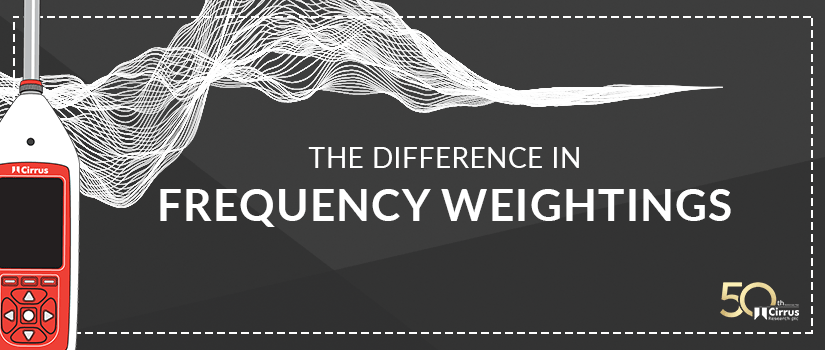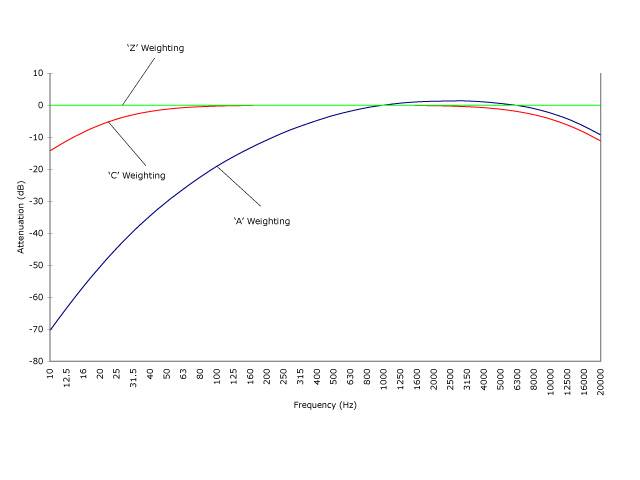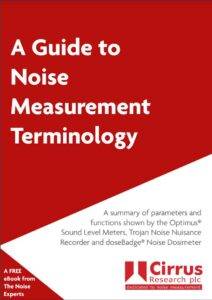What are A, C & Z Frequency Weightings?

On your sound level meter or noise meter, you will often see references to frequency weightings, but what does this mean?
Our ears are most sensitive to frequencies between 500Hz and 6kHz and are less sensitive to frequencies above and below these. For a sound level meter or noise dosimeter to measure and report noise levels that represent what we hear, frequency weightings are used. These are electronic filters within the instrument that adjust the way the instrument measures the noise.
The most used frequency weightings you will see on a modern sound level meter, or noise dosimeter are ‘A’, ‘C’ and ‘Z’. The Cirrus Optimus Sound Level Meters will measure all three frequency weightings at the same time, saving you the risk of measuring the wrong parameter.
‘A’ Frequency Weighting
This is the standard weighting of the audible frequencies and reflects the response of the human ear to noise.
The ‘A’ weighting filter covers the full frequency range from 20Hz to 20kHz, but the shape approximates the frequency sensitivity of the human ear.
Measurements made using A-weighting are usually shown with dB(A) to show that the information is ‘A’ weighted or, for example, as LAeq, LAFmax, LAE etc.
‘C’ Frequency Weighting
This is a standard weighting of the audible frequencies commonly used for the measurement of Peak Sound Pressure level.
Measurements made using the C-weighting are usually shown with dB(C) to show that the information is C-weighted or, for example, LCeq, LCPeak, LCE etc.
‘Z’ Frequency Weighting
This is a flat frequency response between 10Hz and 20kHz ±1.5dB excluding microphone response.
Measurements made using Z-weighting are usually shown with dB(Z) to show the information is Z-weighted or, for example, LZeq, LZFmax, LZE etc.
All frequency weightings are defined in the standards to which a noise measurement instrument is designed. For example, the frequency weightings used on a sound level meter are defined in IEC 61672:2003 (BS EN 61672-1:2003).
 The A, C & Z Frequency Weighting is measured simultaneously by all our Optimus® Sound Level Meters. Simply select the applications, features and functions you require and we’ll tell you the best sound level meter for your requirements.
The A, C & Z Frequency Weighting is measured simultaneously by all our Optimus® Sound Level Meters. Simply select the applications, features and functions you require and we’ll tell you the best sound level meter for your requirements.
Need to measure noise at work?
Check out the Optimus+ Red
The Optimus+ Red is our purpose-built noise at work sound level meter, designed to IEC 61672 standards. Available as an octave band sound level meter, it’s the all-in-one solution for noise at work assessments.
Measuring personal noise exposure?
Check out the Professional doseBadge5
The Professional doseBadge5 is an advanced noise dosimeter for the measurement of personal noise exposure levels in the workplace. With Bluetooth connectivity and octave band filters as standard, it’s complete solution for noise at work and personal noise exposure assessments.
Monitoring environmental noise?
Check out the Environmental Noise Measurement Kit
Compatible with the Optimus+ Green sound level meter, the Environmental Noise Measurement Kit is the perfect solution for long-term outdoor noise monitoring. With 3G/GPRS connectivity, you can view your data in the cloud and get real-time alerts to your phone.
Jaymee-lee Tolliday
Latest posts by Jaymee-lee Tolliday (see all)
- Turning Down the Volume: How the Trojan Noise Nuisance Recorder can help create a quieter world - 13th February 2024
- Festive Opening Hours 2023 - 6th December 2023
- Award of Excellence for Cloud-Based Monitoring Solutions 2023! - 20th November 2023

